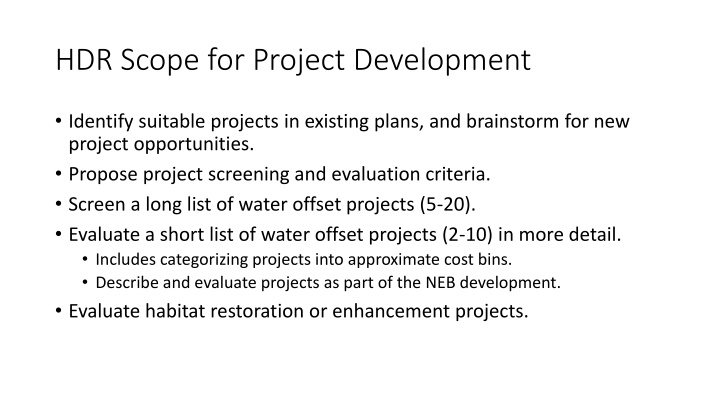
Scope for Water Offset Project Development
This project development scope involves identifying existing and new water offset projects, proposing screening and evaluation criteria, categorizing projects by cost, evaluating habitat restoration projects, and integrating projects into the NEB development process. The process includes screening a long list and evaluating a short list of water offset projects, as well as developing new projects based on established criteria. Various sources are utilized to create project lists, and the next steps involve compiling existing projects, defining screening criteria, and evaluating projects to accommodate NEB evaluation requirements.
Download Presentation

Please find below an Image/Link to download the presentation.
The content on the website is provided AS IS for your information and personal use only. It may not be sold, licensed, or shared on other websites without obtaining consent from the author. If you encounter any issues during the download, it is possible that the publisher has removed the file from their server.
You are allowed to download the files provided on this website for personal or commercial use, subject to the condition that they are used lawfully. All files are the property of their respective owners.
The content on the website is provided AS IS for your information and personal use only. It may not be sold, licensed, or shared on other websites without obtaining consent from the author.
E N D
Presentation Transcript
HDR Scope for Project Development Identify suitable projects in existing plans, and brainstorm for new project opportunities. Propose project screening and evaluation criteria. Screen a long list of water offset projects (5-20). Evaluate a short list of water offset projects (2-10) in more detail. Includes categorizing projects into approximate cost bins. Describe and evaluate projects as part of the NEB development. Evaluate habitat restoration or enhancement projects.
Context in Overall Workflow Context in Overall Workflow
Sources to Develop Project List Sources to Develop Project List Ecology s Trust Water Rights Program Water Acquisitions Program Water Banking Program Stormwater, Flood Hazard Management or Watershed Plans Water System Plans (municipal and group A/B) Wastewater Utility Capital Investment Plans Reclaimed water conveyance and infiltration TMDL Implementation Plans Puget Sound Salmon Recovery Four Year Work Plan and NTAs Historic grant applications to Ecology, Health, or others that had flow benefits but weren t funded
Next Steps Next Steps Existing Projects in Plans Compile existing projects: August 31 Define project screening criteria: In process Develop Project List Evaluate existing projects Develop new projects based on screening criteria Develop New Projects Develop top projects at a more detailed level to Screen Projects with criteria TBD accommodate NEB evaluation Develop Retained Projects; apply temporal and spatial scaling rules, TBD Logic for Offsets Not Occurring In-Place and In-Time, TBD
Projects- Screening Criteria Status Draft Methods being reviewed by WRIA 7-9 technical support team. Draft review by Ecology and then subsequent submittal to WRE committees for review. Screening attributes will drive collection of project information. Draft Methods Attributes are categorized (NEB, Feasibility, Implementation, Habitat) Scored 0 (fatal flaw), 1, 3, or 5. Fatal flaws cause the overall score to be zero Scores in each category are expressed as percent of perfect score Categories can be weighted Weighted category scores are summed; Summed scores range from 20 - 100
